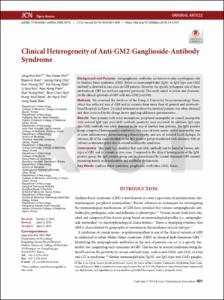Clinical Heterogeneity of Anti-GM2-Ganglioside-Antibody Syndrome
- Keimyung Author(s)
- Seok, Hung Youl
- Department
- Dept. of Neurology (신경과학)
- Journal Title
- Journal of Clinical Neurology
- Issued Date
- 2018
- Volume
- 14
- Issue
- 3
- Keyword
- Guillain-Barré syndrome; ganglioside; antibodies; GM2; Korea
- Abstract
- Background and Purpose:
Antiganglioside antibodies are known to play a pathogenic role in Guillain-Barré syndrome (GBS). Either an immunoglobulin (Ig)G- or IgM-type anti-GM2 antibody is detected in rare cases in GBS patients. However, the specific pathogenic role of these antibodies in GBS has not been reported previously. This study aimed to define and characterize the clinical spectrum of GBS with anti-GM2 positivity.
Methods:
We reviewed the database of the Dong-A University Neuroimmunology Team, which has collected sera of GBS and its variants from more than 40 general and universitybased hospitals in Korea. Detailed information about the involved patients was often obtained and then corrected by the charge doctor applying additional questionnaires.
Results:
Four patients with acute monophasic peripheral neuropathy or cranial neuropathy with isolated IgM-type anti-GM2-antibody positivity were recruited. In addition, IgG-type anti-GM2 antibody was solely detected in the sera of another four patients. The IgM-positive group comprised heterogeneous syndromes: two cases of acute motor axonal neuropathy, one of acute inflammatory demyelinating polyneuropathy, and one of isolated facial diplegia. In contrast, all of the cases enrolled in the IgG-positive group manifested with dizziness with or without oculomotor palsy due to cranial neuropathy syndrome.
Conclusions:
This study has identified that anti-GM2 antibody can be found in various subtypes of GBS and its variants in rare cases. Compared to the clinical heterogeneity of the IgMpositive group, the IgG-positive group can be characterized by cranial-dominant GBS variants presenting mainly with oculomotor and vestibular dysfunctions.
- Keimyung Author(s)(Kor)
- 석흥열
- Publisher
- School of Medicine (의과대학)
- Citation
- Jong Kuk Kim et al. (2018). Clinical Heterogeneity of Anti-GM2-Ganglioside-Antibody Syndrome. Journal of Clinical Neurology, 14(3), 401–406. doi: 10.3988/jcn.2018.14.3.401
- Type
- Article
- ISSN
- 1738-6586
- Source
- https://thejcn.com/DOIx.php?id=10.3988/jcn.2018.14.3.401
- Appears in Collections:
- 1. School of Medicine (의과대학) > Dept. of Neurology (신경과학)
- 파일 목록
-
-
Download
 oak-2018-1734.pdf
기타 데이터 / 344.92 kB / Adobe PDF
oak-2018-1734.pdf
기타 데이터 / 344.92 kB / Adobe PDF
-
Items in Repository are protected by copyright, with all rights reserved, unless otherwise indicated.